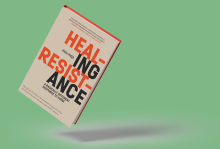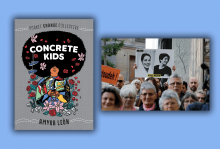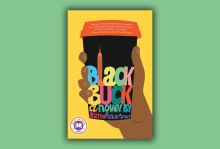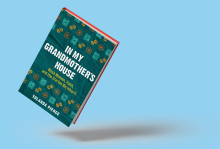Arts & Culture

NONVIOLENCE. WHEN YOU hear the term, what do you think? In your mind’s eye, what do you see? Black and white newsreels of college students dressed in their Sunday best, picketing segregated businesses? Perhaps you imagine Gandhi’s historic salt march to the sea or Martin Luther King Jr. leading the faithful onto the Edmund Pettus Bridge in Selma.
It’s not uncommon to hear “nonviolence” and think “protest.” There is much value in this association. History demonstrates that nonviolence can be an effective tactic for promoting political change. But in Healing Resistance: A Radically Different Response to Harm, Kazu Haga shows us that it can be much more than a political tool.
Haga—a nonviolence trainer and founder of East Point Peace Academy in Oakland, Calif.—was influenced by the Kingian nonviolence principles and curriculum of Bernard LaFayette Jr. and David C. Jehnsen (who co-wrote this book’s foreword). Haga weaves these principles with lessons from Buddhism, social justice activism, and trauma work, illustrating how we might embrace nonviolence to transform both ourselves and our world.

I MAY DESTROY YOU, Michaela Coel’s brilliant 12-episode series released last summer on HBO (and BBC One), chronicles the haphazard recovery of millennial writer Arabella Essiedu after she survives a sexual assault. In Coel’s hands, Arabella (played by Coel herself) is never reduced to a battered woman or a perfect victim. She remains, throughout, entirely human—as do her friends and family. Watching the show reminded me of a line from Bertolt Brecht’s Messingkauf Dialogues in which an actor protests that he cannot play both “butcher and sheep.” Coel seems to disagree. Her Arabella is both warm and wildly narcissistic, armed with a righteousness that often wobbles into unbridled megalomania.
I May Destroy You is a champion of nuance. Although rape is allowed its own category of awfulness, Coel, as writer, draws her audience into other situations that aren’t so clear cut.Each episode is as compassionate as it is damning of human selfishness and myopia. Considering how little mainstream television centers the trauma and healing of Black women (much less with complexity), the critical acclaim Coel has accrued thus far is not surprising. Unfortunately, as is so often the case with art made by people of color, Black women in particular, this acclaim has yet to materialize in awards. I have mixed feelings about awards, especially when the diversity conversation in Hollywood seems in love with its own stagnancy. However, that doesn’t mean awards aren’t nice to have, or that their conferral signifies nothing; awards often reveal the white cultural establishment’s willingness to give something up. After all, if I May Destroy You gets nominated for a [insert trophy here], “Memily in Maris” might not win!

Captured Behind Bars
Filmmakers in Iran risked arrest to help document Nasrin, a compelling portrait of Iranian human rights lawyer and political prisoner Nasrin Sotoudeh. The film highlights her activism and the power of the Iranian women’s rights movement today. Virgil Films.
Return to the Roots
Who Stole My Bible? Reclaiming Scripture as a Handbook for Resisting Tyranny, by Jennifer Butler, remedies authoritarian misrepresentations of the biblical mandate for justice. This practical guide dissects nine Bible stories and presents tools for embodying faith as liberation. Faith in Public Life.

THE LAST CHAPTER of Hebrews in the New Testament begins with a reminder of how to serve God and build a healthy community: “Do not neglect to show hospitality to strangers, for by doing that some have entertained angels without knowing it” (13:2). Biblical hospitality takes many forms, but it consistently involves selfless sharing of space, resources, and—perhaps most importantly—attention. To share part of your life with another person, and allow them to share in return, is to show that they matter.
Nomadland, Chloé Zhao’s contemporary American road film, is full of biblical hospitality. By turning a documentary-style eye on a real community of nomads who otherwise slip through the cracks of society, writer and director Zhao’s film—which won 2021 Golden Globes for best motion picture and best director—provides its actors/subjects with space to be seen, heard, and known.
Like The Rider, Zhao’s previous film, Nomadland combines elements of narrative and documentary filmmaking by crafting a story around the lived experiences of real people. Our guide, Fern (Frances McDormand), leaves her home in Empire, Nev., to live on the road. Fern is part of a subculture of older adults who, left in dire financial straits by the 2008 recession, live in vans as modern-day nomads, picking up gig work across the country. As Fern travels, she makes friends with several fellow nomads (most of them real people playing themselves) who share their stories with her.

WHEN ELIZABETH MAGIE invented The Landlord’s Game, known today as Monopoly, she drew up two sets of rules: one “monopolist,” employing fierce competition and cutthroat property snatching, as the game is played today; the other “anti-monopolist,” namesake of a larger movement intended to demonstrate the dangers from unregulated wealth accumulation by the few and economic inequity in the late 1890s. Magie hoped that soon “men and women will discover that they are poor because Carnegie and Rockefeller, maybe, have more than they know what to do with.”
For Magie, daughter of an abolitionist and anti-monopolist, game creation was not simply an innocent pastime. She resonated with how games could provide a way to envision a new reality and usher in robust ideas.
When I was in college, several of my classmates in a world Indigenous literature class talked about how games we grew up playing—from Monopoly to Settlers of Catan—embodied settler colonialism and capitalism. In Settlers, the goal is to build as much as you can in unoccupied land and accumulate resources. In Monopoly, you aim to procure ownership of as many properties on the board as you can, raising rent to force other players into bankruptcy while you elude jail. Ticket to Ride-USA encourages players to build railroads across the United States, invoking the forces of manifest destiny without a critical lens. Jamaica is a board game where European pirates surround the island and battle for the most resources. Bang! The Dice Game catalogs life in the “Wild West,” where the French, Mexicans, and “Indians” fight each other; one dice roll can “save” a player from an “Indian attack.”

In Shakespeare's plays as in real life: When evil makes itself known, pay attention.

A year ago, I thought it’d be a stretch to get most folks to take abolition seriously. Then the pandemic hit.

The film immerses us in the mind of 80-year-old Anthony (Anthony Hopkins) as he navigates the onset of dementia and his increasing dependence on his daughter, Anne (Olivia Colman). In a recent interview with Zeller, he told me the play was based on his own experience of caring for his grandmother as she battled dementia, when he was just a teenager.

Where the particularly eclectic Venn diagram of true crime enthusiasm and religious history nerdery overlap, you’ll find your binge-worthy streaming recommendation for the weekend: Netflix’s compelling new limited series, Murder Among the Mormons.

Grief is a powerful, disorienting thing, as so many can attest this second Lenten season of a global pandemic that has claimed more than 2.5 million lives. “I’m so tired,” says Wanda Maximoff in the penultimate episode of Disney+ and Marvel Studios’ hit show WandaVision. “It’s just like this wave washing over me again and again. It knocks me down, and when I try to stand up, it just comes for me again. And I … it’s just gonna drown me.” Wanda is referring to the loss of her twin brother, Pietro, but the picture of grief is familiar.

Stories for all of us who’ve had the courage to admit that nope, we’re not okay, and this is hard.

Keep your eyes on your work. Looking
at a dogwood does not make you blossom.
Nor can a bridge of sighs span an ocean
of despair. For that, you need oars
and strong arms. Labor as long
as it is still called today. Yes, Faith
could have worn other metaphors,
but instead it rose from the dead
and asked questions: Why are you
crying? Who are you looking for?
Do not fear. Answer. The Risen One
speaks your language.

HOW DO WE love someone with a mental illness? In a NAMI blog post titled “How To Love Someone With A Mental Illness,” the writer notes, “Choosing to love someone who acts or feels unlovable can be part of what helps them see they are valued as a whole person, they are not the sum total of their pain … Mental illnesses are illnesses, and sometimes they can change someone’s circumstances … they can even change their personalities for a time, change their interests, their spirit. But they are the same person you have always loved, and they need you to see that person in them—even when they can’t see themselves clearly” (emphasis mine).
After all, mental illness does not change the fact we are beloved children of God. Even though they are the same person you have always loved, it can be hard to recognize them. Looking through God’s eyes helps us to see past the label and the diagnosis.
A great example of “choosing to love” came to me through a story from my friend Monique. Over lunch, I asked Monique what I thought was a philosophical question about marriage and mental illness. The conversation turned personal very quickly, however.
Monique shared with me that her vision for her marriage is to flourish, knowing both she and her partner have mental illness. She said flourishing for their marriage happens when they are up front with each other about their mental health status, can state their needs, and can get the support they need.
Reprinted with permission by Chalice Press.

IN HIS DEBUT novel Black Buck, Mateo Askaripour tackles race in the world of startups. Doubling as a kind of self-help manual for Black people in sales, the novel’s structure and tone allow it to hold multitudes: the dark, the hopeful, the comical, the horrific. But at its heart, this is also a novel about community.
We meet Darren, a 22-year-old shift supervisor at Starbucks who lives with his mother in Bed-Stuy, Brooklyn, New York. They’re not poor, he insists, pointing to the home his mother owns. But this doesn’t negate the harsh conditions she is exposed to at her factory job. Still, life is good—and if a day is not “good,” then at least he can come home to a warm dinner with his mother, girlfriend, best friend, and the neighbor who is practically family. Darren would be content, if not for a few reminders that he could aim higher, achieve more. He was, after all, valedictorian of his class at the Bronx School of Science.
Enter Rhett, the charismatic CEO of Sumwun, a startup located on the 36th floor of the building where Darren works. When Darren smoothly attempts to sell Rhett a new drink, Rhett sees his potential and recruits him. This is how Darren becomes Buck, the first Black man at Sumwun. Racist shenanigans ensue, popular among them: Has anyone told Darren that he looks like Martin Luther King Jr.? Sidney Poitier? Dave Chapelle? Against a background of overt racism, appropriation, and consumerism, the cult-like culture of Sumwun is unforgiving. Meanwhile, the company’s mission is opaque, rife with danger and risk. What impact are they really making? Are they helping anyone? Where is all the money coming from?

SOMETIMES I WONDER if my “Black card” is in jeopardy. The main source of this concern is that my encounters with the Black church are few, the most consistent being the yearly family viewing of the 1996 film The Preacher’s Wife, though even I know the brevity of that movie’s scripted sermons is far from accurate. My few in-person Black church experiences taught me the basics: Wear your Sunday best, and expect the service to be long. But beyond that, the Black church has always been a bit of a mystery to me, a place that has never felt familiar.
Yolanda Pierce’s In My Grandmother’s House provides an intimate entry into this world. From tarry nights and foot washing to patriarchal structures, Pierce details her experiences and invites the reader into the tension of celebrating the beautiful aspects of the Brooklyn Holiness-Pentecostal church of her youth while also laying bare the ways in which that church, and the Black church at large, has failed to be the loving and inclusive body it professes to be.
In the preface, Pierce describes her book as “a work of Grandmother theology,” a womanist theology that draws on the generational wisdom of older Black women and provides a different way to know God. With the childhood stories she tells, Pierce seems to identify her grandmother Vivian—the woman who raised her, served faithfully in the church, and whose home displayed a portrait of a Black Jesus—as the primary theologian in her life. In a culture that so often elevates the thoughts and analysis of white, male theologians, to read and reflect upon the lessons that Pierce learned from her grandmother and her church mothers makes an impact, lessons that continue to inform how she lives today.

LIKE THE FRENCH police officer in Casablanca who was “shocked, shocked” to find gambling in Rick’s Cafe, in the wake of the Jan. 6 riot at the U.S. Capitol, social media companies were “shocked” to discover violent anti-Semitic and white nationalist agitators lurking in plain sight on their platforms. With their usual earnest hypocrisy, the companies took action, banning tens of thousands of groups and individuals from the social media universe. Facebook and YouTube suspended Donald Trump’s accounts. Twitter permanently banned him.
Never mind that in the preceding days and weeks those same social media platforms hosted the planning for Jan. 6, or that for years they have profited from a business model that ignores truth and promotes outrage. But when some of their more unruly customers got off the leash and started threatening the people who write antitrust laws, Facebook, Google, and Twitter suddenly became tribunes of civility.
Of course, such monumental hypocrisy from Big Tech gave many Republican politicians the opportunity to change the subject from their own possible complicity in the insurrection to what they claim is suppression of free speech by the liberals in Silicon Valley. To this, clever liberals have replied that the First Amendment only applies to government, not to private corporations.

Future Soul
Virtuoso keyboardist Cory Henry’s 2020 album Something to Say encapsulates a trying year—traversing elation and sorrow. He brings Herbie Hancock-worthy skill and range to what he calls “future soul.” Featuring the Funk Apostles on four tracks, this self-produced project is required listening. Henry House Entertainment.
A Divine Puzzle
Author and public theologian Grace Ji-Sun Kim’s essays read as meditations in her newest book, Hope in Disarray: Piecing Our Lives Together in Faith. Sifting through today’s complex array of personal and societal injustices, Kim approaches readers with the gift of generative hope. The Pilgrim Press.

IN MIDDLE SCHOOL I emailed CBS and asked them to make a teen version of their reality show Big Brother, in the hope that they would cast me and I could schmooze and deceive my peers to win the contest’s $500,000 prize. Schmooze and deceive weren’t my bright ideas: They formed a strategy I had seen succeed on previous seasons of Big Brother and Survivor, as clueless heroes were undone by ruthless, money-hungry, victorious villains. Even CBS’ clean-fun competition The Amazing Race had enabled contestants to backstab another team for $1 million.
So it’s unexpected that the network’s newer prime-time contest Tough as Nails plays to kinder rules—and that it has become part of my mostly drama-filled viewing habits. Twelve Americans with some of the most strenuous jobs that exist (welder, farmer, firefighter, ironworker, and more) vie in team and individual challenges to see who’s the hardest and smartest worker. As an artsy guy whose most physically demanding professional activity is typing, I would not have pictured myself in the Tough as Nails fan base. And yet, here I am.

IT'S UNLIKELY THAT Donald Trump is fretting over his presidential portrait. With further legal troubles and several industries turned against him, the man has bigger fish to fry. But as we’ve learned time and time again through the ravages of the coronavirus and police violence, just because Trump isn’t worried about something doesn’t mean it doesn’t matter. The unconfirmed, though expected, portrait offers a chance for him to shape a legacy that is in dire need of salvaging. Trump’s painting could serve to underscore—or attempt to elide—the unconventional nature of his time in office, potentially adding a glossy filter to a difficult period in American history. Of course, filtering is more than part and parcel of portraiture. It’s the very nature of the job.
Throughout the centuries, portraiture has been the province of the wealthy and, despite its biographical nature, is a genre that conceals nearly as much as it reveals. Louis XIV, another larger-than-life leader, exhibits this multiplicity of meaning all too well in his portraits. Painter Charles Poerson clothes Louis XIV in the garb of Jupiter—complete with lightning bolts in hand—to signify his victory over a series of nobility uprisings known as the Fronde. By shrouding the king’s humanity, Poerson makes Louis into someone divine, armed with greater might than mere mortals. Who needs the imago dei when you can simply be God? A different portrait replaces the gouty king’s legs with the calves of a younger man. In short, the sovereign portrait is synonymous with a kind of psychological trompe l’oeil, created to preserve power and project glory. American presidential portraits differ in their ends, though they are invested in other kinds of self-delusion: equality and equanimity.

The contemporary Christian music industry has been adamantly opposed to affirming LGBTQ+ people. But Semler's EP Preacher's dares to include songs about queer sexuality, lesbian weddings, and Christian faith.